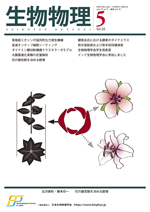
- |<
- <
- 1
- >
- >|
-
Mitsunori TAKANO2019 Volume 59 Issue 5 Pages 237
Published: 2019
Released on J-STAGE: September 27, 2019
JOURNAL FREE ACCESSDownload PDF (507K)
-
Motoshi KAYA2019 Volume 59 Issue 5 Pages 241-247
Published: 2019
Released on J-STAGE: September 27, 2019
JOURNAL FREE ACCESSDespite numerous information on the molecular properties of skeletal myosin, its ensemble effects on collective force generation have not been rigorously clarified. This review introduces experimental and modeling approaches to investigate collective properties of skeletal myosin and explains how molecular properties of myosin are tuned to enhance the coordinated force generation among molecules. Such a cooperative force generation is essential for efficient muscle contractions.
View full abstractDownload PDF (13413K) -
Shinya SAKUMA, Yusuke KASAI, Fumihito ARAI2019 Volume 59 Issue 5 Pages 248-254
Published: 2019
Released on J-STAGE: September 27, 2019
JOURNAL FREE ACCESSRecent researches on single cell analysis have provided important results showing differences between the individual cells even in the same culture group. On-chip cell sorting techniques represented by the fluorescent-activated cell sorting (FACS) using microfluidic chips have greatly contributed to these analyses because of their remarkable high-throughput ability. Currently, the cell sorting faces to a chance of further leap with the aid of microfabrication technologies and microfluidic flow control technologies for constructing the high-throughput system. In this article, we give a commentary for the on-chip cell sorting from the sight of sorting methods.
View full abstractDownload PDF (1501K) -
Kohji TAKEI, Hiroshi YAMADA, Tetsuya TAKEDA2019 Volume 59 Issue 5 Pages 255-261
Published: 2019
Released on J-STAGE: September 27, 2019
JOURNAL FREE ACCESSDynamin GTPase, an essential endocytotic protein, helically polymerizes at the neck of endocytic pits, and mechanically sever the membrane upon GTP hydrolysis. However, it is not known exactly how the dynamin disconnect the membrane. To clarify the mechanisms we analyzed structural changes of dynamin complexes during membrane fission using electron microscopy and high-speed atomic force microscopy (HS-AFM). Surprisingly, the dynamin ring complexes were clustered upon GTP hydrolysis and membrane constriction occurred at uncoated regions between the clusters, suggesting a novel mode of action of dynamin. In this commentary, we illustrate dynamin’s membrane fission models proposed thus far, and our novel “clusterase” model.
View full abstractDownload PDF (5011K)
-
Chikara FURUSAWA, Takaaki HORINOUCHI2019 Volume 59 Issue 5 Pages 262-265
Published: 2019
Released on J-STAGE: September 27, 2019
JOURNAL FREE ACCESSDuring adaptive evolution, phenotype and genotype dynamically change; however, the relationship between these changes and associated constraints is yet to be fully elucidated. In this review, we focus on the analysis of phenotypic and genotypic changes occurred in Escherichia coli cells during laboratory evolution experiments. We demonstrated that the change of fitness can be quantitatively predicted by the expression changes of a small number of genes, suggesting that phenotypic changes in adaptive evolution are constrained on relatively low-dimensional dynamics. The automated system for laboratory evolution is also presented, which enables us to achieve large-scale data in bacterial adaptive evolution.
View full abstractDownload PDF (2406K) -
Miho KITAZAWA, Koichi FUJIMOTO2019 Volume 59 Issue 5 Pages 266-270
Published: 2019
Released on J-STAGE: September 27, 2019
JOURNAL FREE ACCESSComponent number of flowers is an important aspect to capture floral morphology. Beside the diversity of floral shapes, basic numbers of the components are restricted to several numbers associated with the major clades of flowering plants. The developmental and evolutionary reason of such restriction has been a question for centuries. To answer this, we employed mathematical models developed for phyllotaxis, i.e., arrangement of leaves around the stem. The model showed that basic numbers of four and five, the major numbers in the largest clade of flowering plants, appeared spontaneously and stably, suggesting that preferences in developmental process underlie the restriction.
View full abstractDownload PDF (1408K)
-
Toshifumi MORI2019 Volume 59 Issue 5 Pages 271-272
Published: 2019
Released on J-STAGE: September 27, 2019
JOURNAL FREE ACCESSDownload PDF (2275K)
-
Shoji TAKADA, Yoko TOYOSHIMA, Akihiko ISHIJIMA2019 Volume 59 Issue 5 Pages 274-275
Published: 2019
Released on J-STAGE: September 27, 2019
JOURNAL FREE ACCESSDownload PDF (2052K) -
Shoji TAKADA, Yoshie HARADA, Yuki SUDO2019 Volume 59 Issue 5 Pages 276-277
Published: 2019
Released on J-STAGE: September 27, 2019
JOURNAL FREE ACCESSDownload PDF (2005K) -
Daisuke NAKANE, Ken NAGAI, Miyuki SAKAGUCHI2019 Volume 59 Issue 5 Pages 278-279
Published: 2019
Released on J-STAGE: September 27, 2019
JOURNAL FREE ACCESSDownload PDF (3720K)
-
[in Japanese]2019 Volume 59 Issue 5 Pages 280-281
Published: 2019
Released on J-STAGE: September 27, 2019
JOURNAL FREE ACCESSDownload PDF (4698K)
-
[in Japanese], [in Japanese]2019 Volume 59 Issue 5 Pages 282-283
Published: 2019
Released on J-STAGE: September 27, 2019
JOURNAL FREE ACCESSDownload PDF (619K)
-
[in Japanese]2019 Volume 59 Issue 5 Pages 284-285
Published: 2019
Released on J-STAGE: September 27, 2019
JOURNAL FREE ACCESSDownload PDF (1784K)
-
2019 Volume 59 Issue 5 Pages 273
Published: 2019
Released on J-STAGE: September 27, 2019
JOURNAL FREE ACCESSDownload PDF (464K)
- |<
- <
- 1
- >
- >|